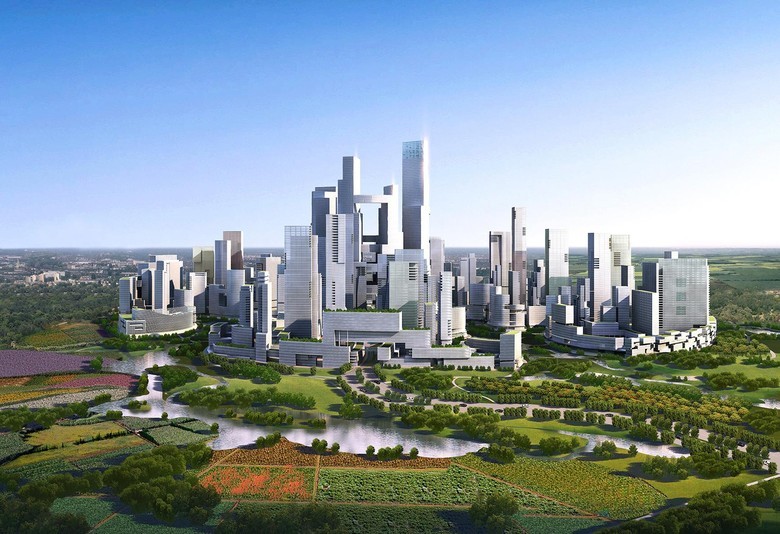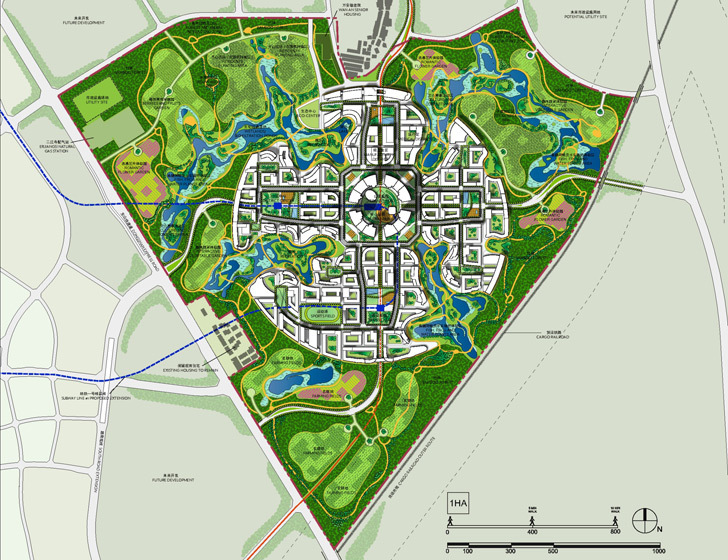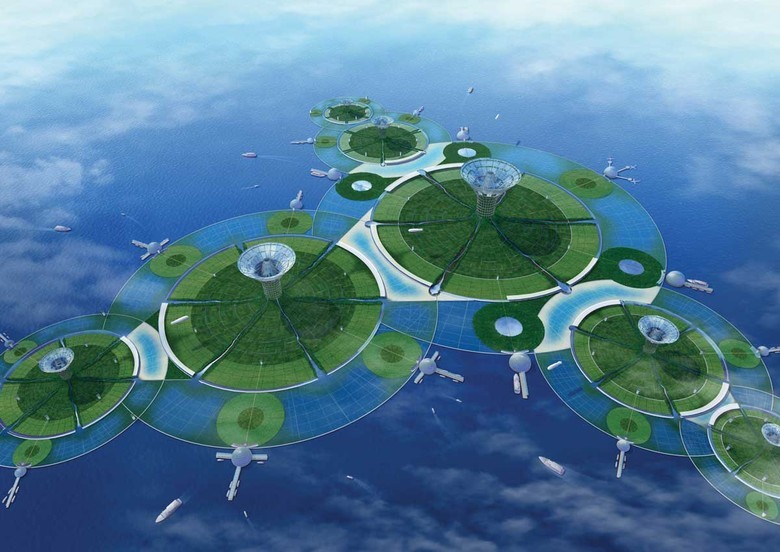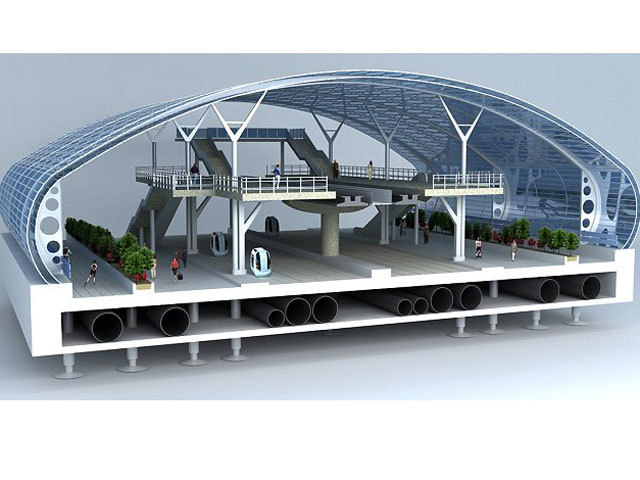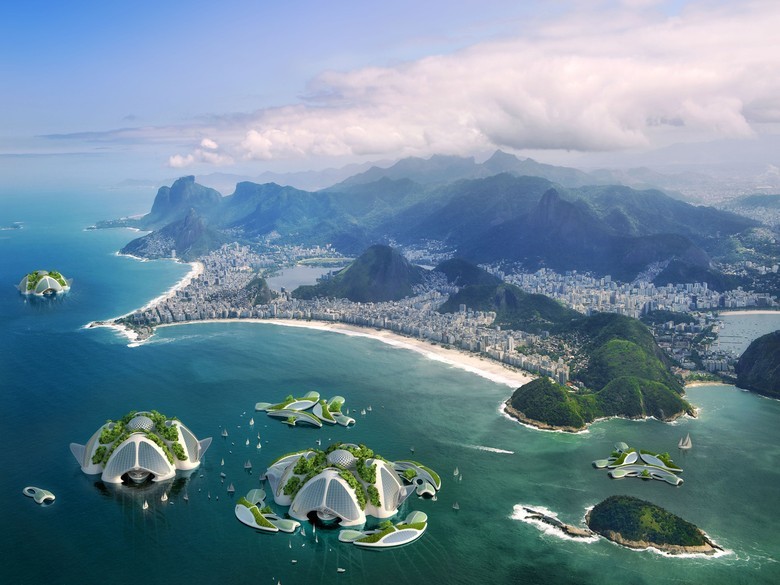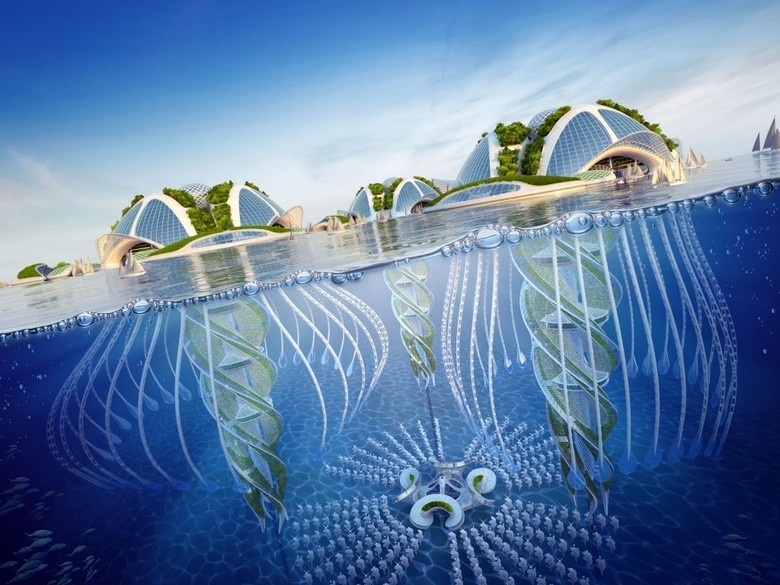Future Cities Not Yet Built
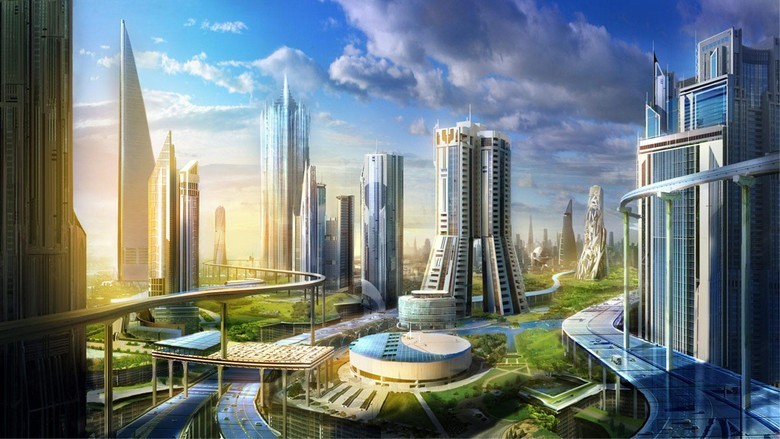
We are accustomed to living in a constantly changing appearance of cities. Older buildings disappear - new ones appear, the usual modes of transport gradually disappear into non-existence - more environmentally friendly counterparts remain. Some architectural styles crowd out others. These changes occur constantly, and we have already ceased to notice them. And if you look 10-20 years ahead and imagine what the cities of the future look like, built from scratch and overflowing with technology?
And here the fantasy draws cities on Mars, cities - space stations, settlements in other galaxies ... Perhaps this will happen. But for the time being we will land back to Earth and tell about the projects of cities of the future that will change the face not only of countries and entire continents, but also of the whole XXI century.
"Great City" without cars, China
"Great City" - a project of an environmentally friendly city, built on a plot of about 3 square kilometers near the city of Chengdu. It is able to solve the generally accepted problem of China - the overloaded infrastructure - due to the almost complete abandonment of cars. The city does not consume much energy, does not pollute the environment with carbon dioxide emissions, more than half of its territory is occupied by green spaces, which can be reached from any house in just two minutes.
Eco-parks will recycle wastewater, solid waste and generate electricity. The local climate is not well suited for solar panels, so all buildings are designed to maximize the use of wind energy.
The “Great City” will be home to 80,000 people, some of whom will be employed on the project itself. The distance between any two points of the city can be walked for 15 minutes, the need for a car is excluded. But not completely. Half of the road space will be retracted for non-motorized transport. With Chengdu and the surrounding neighborhoods, the city will be communicated through a network of transport communications, forming a regional transit hub in the center of the city.
Desert Rose, Dubai
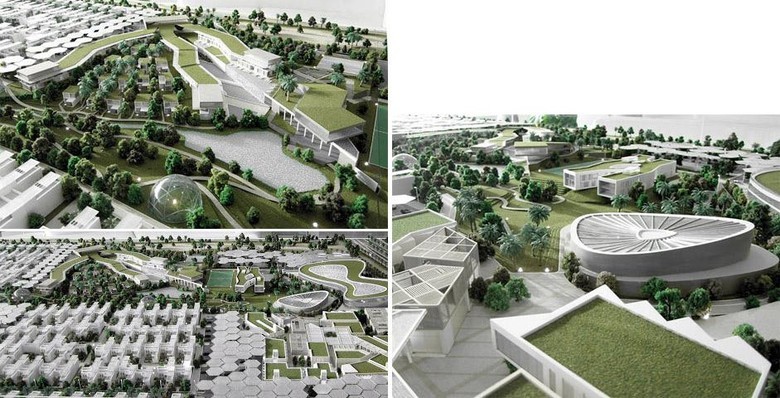
Green "Desert Rose". A source
“Desert Rose” is the name of a satellite city project of 14 thousand hectares, which will use only environmentally friendly transport, and a land line will connect it with Dubai. Electricity will be supplied from alternative renewable sources. In addition, air-conditioned footpaths are provided in hot weather. Construction of the city will take ten years and will be held in four stages.
The project includes 550 comfortable villas, educational institutions and organic farms, the energy for which will be generated using 200 square kilometers of solar panels. Solar panels will be able to provide half of the needs of the city, and the use of environmental transport compensates for the remaining part of carbon dioxide emissions.
Floating Greens, Japan
Growing up is a standard solution for the development of cities in the Asian region, but for Japan this method is not always good because of the frequent threats of earthquakes and tsunamis. But then the Japanese found another way out - to build cities on the water! This city was the project "Floating greens", consisting of ten islands, like water lilies, and with central towers about a kilometer high.
Towers should accommodate more than 30 thousand people. At the top will create a space for work, shops and service companies. In the middle of each tower is a farm place for growing fruits and vegetables. The base of the island is used for a residential area that accommodates 10 thousand people, as well as forests and beaches. Each floating oasis will be fixed at the bottom of the ocean.
The world's first underwater city, Japan
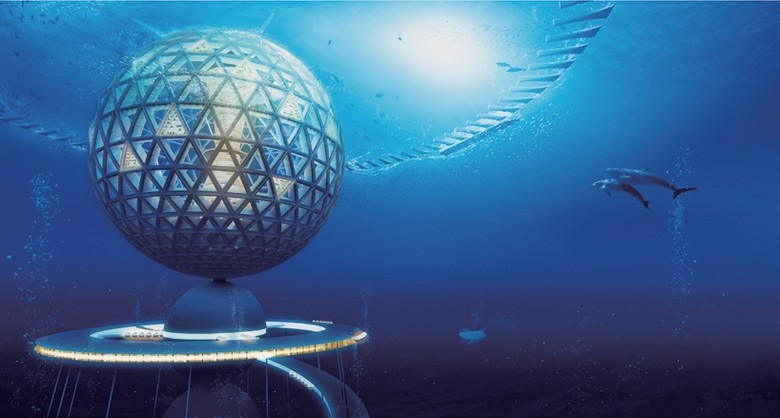
Spherical city under water. A source
But for the Japanese, the idea of a floating city is far from new: by 2035, they plan to create the world's first underwater city, Ocean Spiral. It will be a spherical structure that can accommodate up to 5 thousand people and receive energy from the bottom of the sea. Oxygen will be converted from carbon dioxide, and a large difference in temperature and pressure is used to produce electricity.
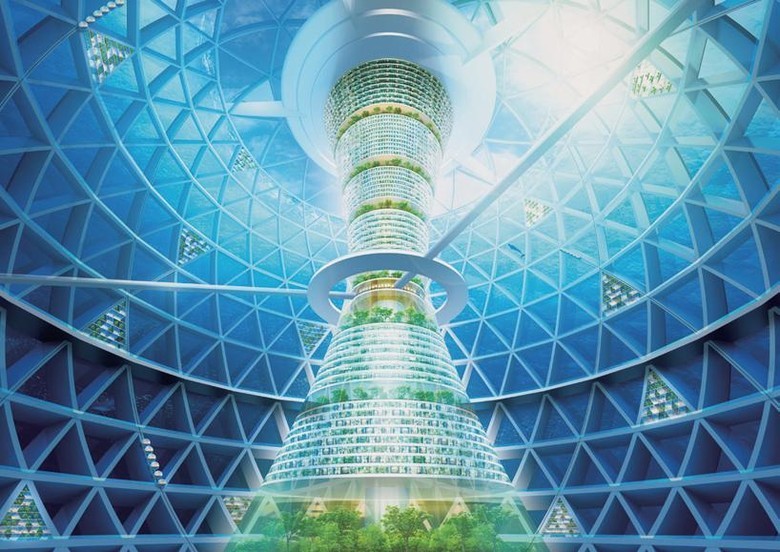
Inside the spherical structure is a skyscraper, designed for living and working 5 thousand people. A source
The form of a high-tech city - huge balls with a diameter of 500 meters and a capacity of 5 thousand people. The balls will be able to float on the surface or sink into the water along a giant spiral structure extending to a depth of 15 kilometers, where a mining plant will appear. The system of huge balls should protect people during earthquakes and tsunamis. The cost of such a structure is estimated at 25 billion dollars, and rubber will be the main building material.
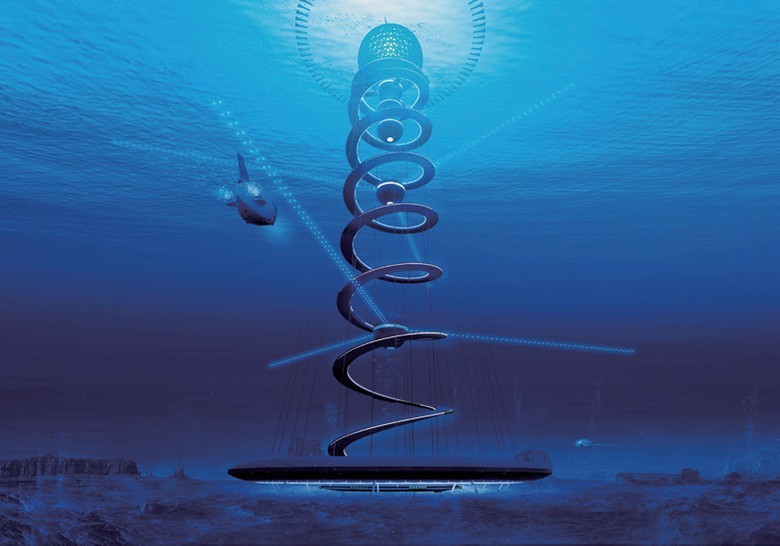
The solid helix rests on the ocean floor, where the mining plant is located. A source
Umka Arctic City Project, Russia
A unique project called “Umka”: they are going to build a city outside the Arctic Circle on the permafrost. The basis is the structure of the International Space Station. For residents of the city will be provided water park, amusement park, its own production of bread and fish products, houses, scientific laboratories, schools, a temple, hotels, a hospital. Urban transport will work on electricity. The size of such a city will be 1.5 kilometers by 800 meters, and the construction will cost about 5-7 billion dollars.

The estimated location is the island of Kotelniy of the archipelago of the Novosibirsk Islands in the Arctic Ocean (approximately 1.5 thousand kilometers from the North Pole). A source
The city is going to create a regulated climate system using space and other advanced technologies. The source of electricity will be a floating nuclear power plant, and all types of waste will be processed at two plants.
India's first smart city
Metropolitan areas such as Delhi and Mumbai are renowned for their industry, infrastructure, financial markets, skilled labor and the presence of foreign companies. But most of India is a poor province with a very low standard of living. That is why the idea of building an industrial corridor (DMIC) between the largest metropolitan areas was born, which will allow developing provinces by creating new jobs and high-tech infrastructure. Cost of such a project will be 90 billion dollars.

India's first smart city Dholer built in the framework of the project of industrial corridor Delhi - Mumbai
We note one very pretentious fact: the Delhi-Mumbai industrial corridor is one of the most important parts of the plan to build hundreds of smart cities throughout the country. Hundreds, Karl! In India! And the first such city will appear in the state of Gujarat. Dholera will be erected in ten years and will become a true technological gem of India: digital traffic control, the absence of pollution, traffic jams and crowds of people. For comparison, the size of Dholera will exceed the size of Mumbai in half.

Gujarat International Finance and Technology City will be one of the very first Indian smart cities. A source
In the same state, another equally futuristic project is being implemented - the International City of Finance and Technology of Gujarat (GIFT). It also involves providing the population with the infrastructure of the future and a variety of jobs. The complex will include offices, schools, residential premises, hotels, a conference center and shopping areas. And the most striking building in this city will be the Diamond GIFT Tower.
Khazar Islands, Azerbaijan
For the construction of a new smart city, Azerbaijan decided to create an artificial archipelago of 44 islands with a total area of 3 thousand hectares. At Khazar Islands (Khazar Island) there will be an airport, a yacht club, a track for Formula 1, houses for 800 thousand people and the longest boulevard in the world - 150 km. The project cost is estimated at 100 billion dollars.
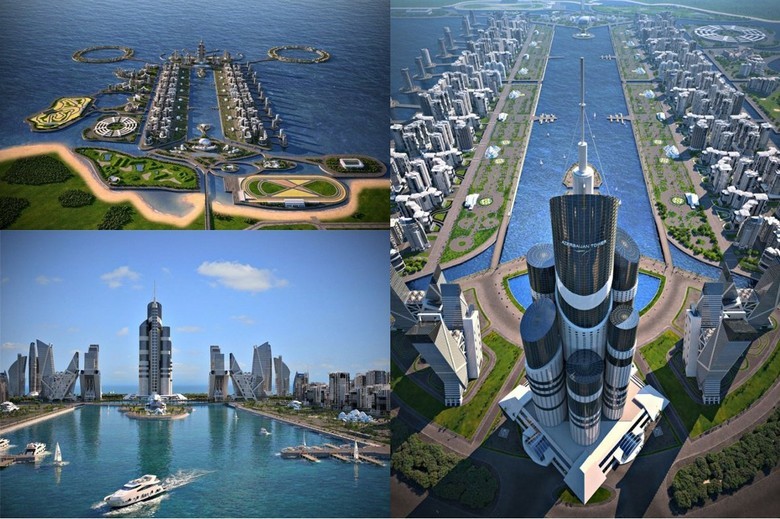
Tower Azerbaijan can be the tallest tower in the world. A source
But the main attraction of the archipelago will be the Tower of Azerbaijan . Its height will reach 1050 meters, which can break the record of the highest tower of the Burj Khalifa. The tower of Azerbaijan will be very strong and will be able to withstand an earthquake of nine points. The skyscraper was planned to be completed by 2018–2019, and the islands - by 2022, but last year construction was postponed indefinitely due to lack of funding.
"Cloud resident" of China

Cities in the clouds - a dream for densely populated areas of the planet. A source
In the Chinese city of Shenzhen, it is planned to build a heavenly city - a new business center of the world. Residential modules, office and IT clusters, public-commercial zones and green terraces will appear in it. The city will include three interconnected towers with a height of approximately 600 meters. The total area of the building is commensurate with the area of the Principality of Monaco, and the windows of the towers will overlook Hong Kong. And this is done on purpose. Local authorities want to demonstrate the new financial capabilities of the Hong Kong region, which represents the old financial model of the world. A smart heavenly city will be able to fully provide itself with environmentally friendly electricity.
Earthfish in Mexico
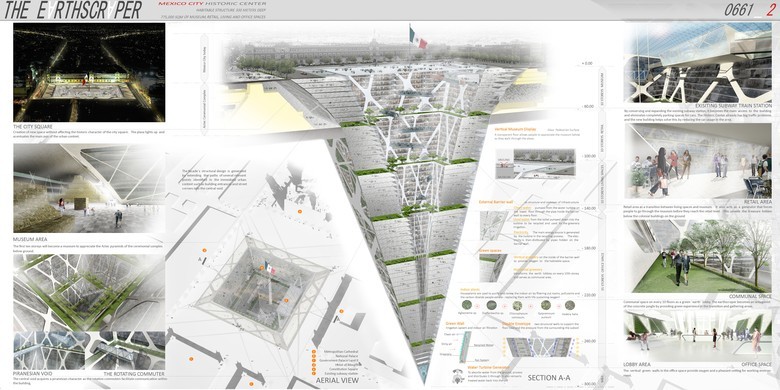
Not a bunker, but a city of the future of a new type - ground-scraper! A source
While other countries see the future of cities in the clouds, Mexico has found another way - a dungeon. Earthscraper (Earthscraper) is a 65-story inverted pyramid of 7618 square meters. He will appear in the center of Mexico City. The roof of the building will be a panel of transparent glass 240 by 240 meters. “Outside” it will look like a public square where residents can enjoy walks, concerts, exhibitions and military parades. The source of energy for the building will be geothermal energy, which will make the underground city self-sufficient.
The first megalopolis of China
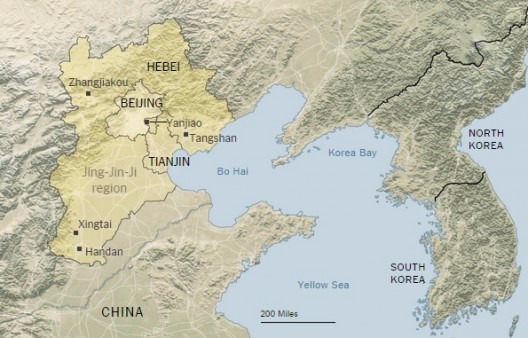
The size of the new Chinese city will surpass the size of London by 137 times. A source
In China, it is planned to create a megalopolis city, Jing-Ching-Ji, which will unite Beijing, Tianjin and Hebei. It is expected to live 130 million people, and its size (212 thousand square kilometers) will exceed the size of more than half of individual countries in the world. Each city in this association has its own role: Beijing is a cultural and technological region, Tianjin is a production district, and small industries will be concentrated in Hebei. So that the road from one city to another takes no more than an hour, new high-speed trains are being built.
City on the water, printed on a 3D printer, Rio de Janeiro
The unusual concept of the Belgian architect Vincento Callebo, who proposed to build a city on the water in the coastal zone of Rio de Janeiro, is worthy of attention. The building material will be a composite of recycled plastic waste and algae, and the city itself will be printed using a 3D printer. Structures for construction can grow independently due to calcium carbonate contained in water, which can form the external skeleton and semipermeable membranes for the desalination of seawater, and microalgae will be used to produce energy for heating and climate control.
Externally, residential structures with a diameter of about 500 meters will resemble jellyfish. They will have a working space, workshops, recycling plants, research laboratories, sports fields and farms. Such a city will be able to provide housing for about 20 thousand people.
The architect solves the problem of food shortage with the help of huge farms (Farmscrapers) in which plants will be grown. Farm place - at the very top of the structures. One of the main tasks of this city will be the construction of scientific centers for the study of the ocean.
Instead of a conclusion: and yet about Mars

For some, fantasies about cities on Mars become not just a plot for a science fiction book, but a whole architectural project. A source
The UAE plans to create a “mini-state and a kind of commune” on Mars for further “international cooperation”. While the city project is called Mars 2117, its construction will begin at least not in the near future. The concept assumes the size of Chicago and a population of 600 thousand people, other details of the project have not yet been disclosed.
Sources
')
Source: https://habr.com/ru/post/370437/
All Articles
